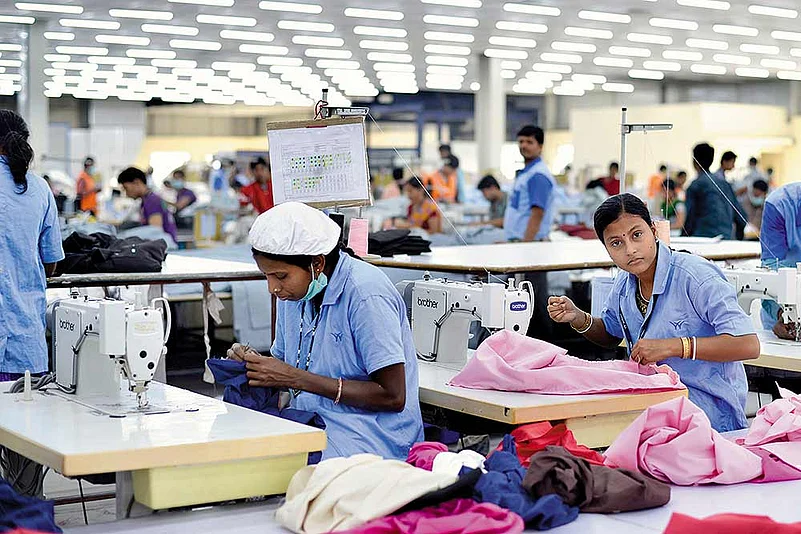Why is female participation in the workforce on the decline in India? It is a conundrum that is flummoxing many. As against a 45.4 per cent median female share of the workforce in 144 countries, a study released by Pew Research Center in March 2017 had ranked India, with 25.9 per cent share, among the 10 lowest. The study was based on labour force data from 2010 to 2016. The latest National Sample Survey Office (NSSO) data for 2017-18, yet to be officially released, shows female participation in the workforce has declined further to 23.3 per cent, as per NSSO data reported by Somesh Jha in a business daily.
The new data raises questions on why women are not participating in the workforce in greater numbers when in most examinations for higher studies or even competitive jobs they seem to outscore male counterparts. The latest NSSO data on youth (15-29 years) shows that their participation has dropped from 37.1 per cent in 2004-05 and 24.4 per cent in 2011-12 to just 16.4 per cent in 2017-18.
“The number of women applying for jobs is increasing, with more opting for higher education. But many opt not to take up a job if the job profile is not what they are seeking,” says R.P. Yadav, CMD Genius Consultant Ltd, a placement agency with over 50,000 employees on its rolls. Yadav feels that the new maternity leave provision of 26 weeks, as against the earlier provision of three months, has done much to put women candidates at a disadvantage when competing for a job against males. “Though the number of women in employment has risen, a recent trend is that a larger number don’t return to work after taking maternity leave. Around 40 per cent opt to quit, bringing down their share,” opines Yadav.
While economists agree that longer maternity leave may have impacted chances of young women below 40 seeking jobs in the formal sector, they point out that this provision does not apply in the informal sector—employer of a vast majority of women. Jayati Ghosh of JNU agrees that maternity leave has rocked the cradle to some extent as the burden has been kept only on the employer. “When you do that, employers would prefer not to employ women. There should be public provision for maternity benefit, which till now does not extend to the informal sector, tiny enterprises and self-employed,” says Prof Ghosh. She feels the government, through the National Food Security Act, should provide monetary help equivalent to three months of minimum wage.
Jayan Jose Thomas of IIT Delhi states that only social factors don’t contribute to the declining trend, as they were there earlier too. “Part of it, in the case of rural women, is due to withdrawal from agriculture due to mechanisation, fall in farm incomes, rapid urbanisation, etc. In 2004-05, we saw a rise in construction jobs, especially for males, which meant more income leading to migration from villages to towns.”

However, decline of women in the urban workforce should be of greater concern. “The period from 2004-05 to 2011-12 was one of the best in terms of economic growth when employment opportunities in industry and services should have increased tremendously, with 15 million jobs being created every year. The actual increase in jobs was, however, only half the potential and women took the brunt of this. Things may have worsened post 2011-12,” says Thomas.
Bina Agarwal, professor of development economics and environment, University of Manchester, points out a striking statistic in the leaked NSSO employment report--the almost three-fold rise in unemployment rates for young rural women (15-29 yrs), from 4.8 per cent in 2011-12 to 13.6 per cent in 2017-18. The urban rate of 27.2 per cent is twice that. “This reinforces what gender economists have long been saying--that women want to work, but lack jobs. The 2011-12 NSS found that 32 per cent of rural women engaged in domestic activities were willing to work, if they found suitable jobs. The much-discussed low labour force participation among Indian women is not due to cultural norms, domestic work burdens and undercounting. It’s increasingly due to lack of jobs. Planning for female employment must also include safe transport and hostels near workplaces.”
Economists say that the way women’s work is defined in surveys is flawed. Sabina Dewan, president of JustJobs Network, states that while female participation in workforce has been sliding over last several years, the extent of the drop, whether female or male, actually depends on how each survey defines women’s work. “If you look across surveys, the levels are not the same. So it is critical to have a standardisation of how we define women’s work,” Dewan states.
Renana Jhabvala, economist and social worker, points to a study conducted in Bihar four years back using NSSO yardstick that had revealed 56 per cent of women were engaged in gainful work, while the NSSO 2011-12 survey had determined 11 per cent women as working. “The difference came up because of our deeper probe. Similar intensive studies in different states have come up with huge difference in data on women in workforce. Which bring us to the question: are we collecting the right data? Is the NSSO missing out a whole lot of women engaged in gainful activity?” asks Jhabvala.
Jhabvala, long associated with the Self-Employed Women’s Association (SEWA), says there is no dearth of women seeking gainful employment. Of the many reasons why numbers of working women are declining, she says, one is that many are opting to continue their education. There is also a push towards mechanisation, including in agriculture and changing family structures, from joint families to nuclear families. “All these factors are leading to the drop. But more problematic is that when women enter the workforce they don’t necessarily find the jobs they are seeking, they are not allowed to progress same as men, they most often don’t even have parity in pay. There is persistent gender inequality in the labour market and women are often relegated to poor value add work,” states Jhabvala.
Studies have also revealed that many women avail of the option not to work, or tend not to work. This worldwide trend is more pronounced in slightly better-off families. The better off you are, the better are the chances of giving up a middling or poor quality job or of quitting for family responsibilities, as a NSSO survey showed.
Indeed, once women take up jobs, factors like work atmosphere, safety, family support etc influence their duration in the workforce. Also, re-entry into the workforce after a break is often difficult, which partly explains the drop in participation. From lack of family support to the easy availability of labour for low value-added jobs—many are the factors that impede a return to work. In purely economic terms, if more women work, the more they have to spend, giving the economy a fillip. More needs to be done to arrest their decline in the workforce.
***
- New maternity leave provision of 26 wks puts women at a competitive disadvantage; many don’t return to work
- Mechanisation, fall in farm incomes, rapid urbanisation, lack of jobs lie behind decline of women in workforce


























